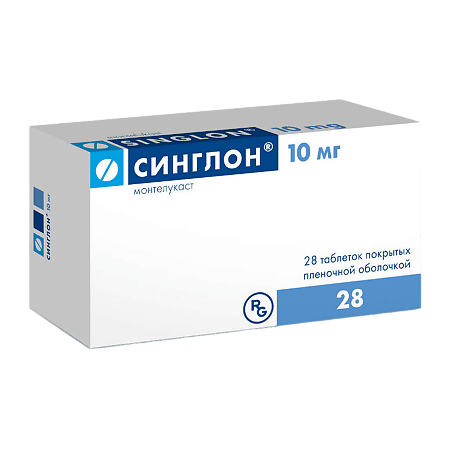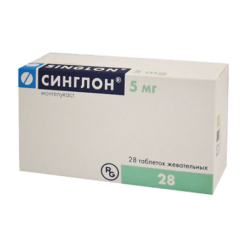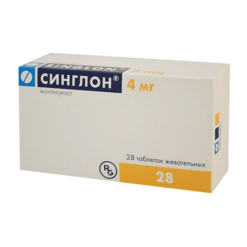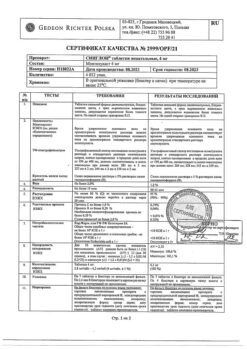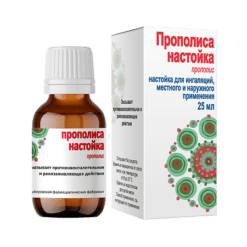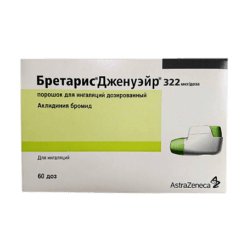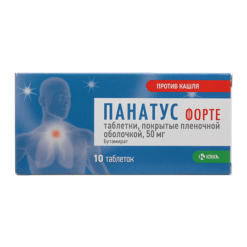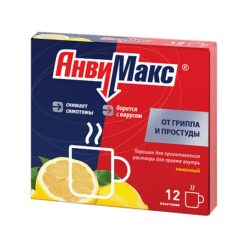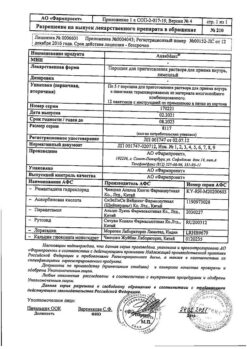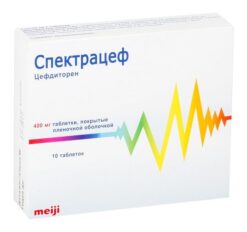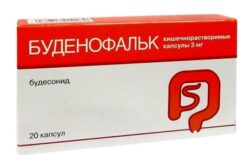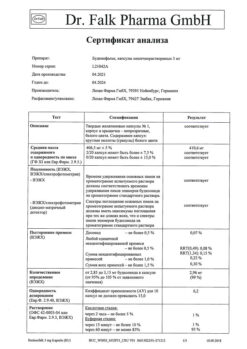No products in the cart.
Singlon, 10 mg 28 pcs.
€35.71 €29.76
Description
Montelukast is a specific oral leukotriene receptor antagonist. Montelukast has the ability to inhibit bronchospasm caused by inhaled LTD4 at very low doses (5 mg). Bronchodilation is observed within 2 h after oral administration. The bronchodilation effect caused by the beta-adrenomimetic is complemented by the effect of montelukast.
Montelukast inhibits the early and late phases of bronchospasm induced by antigen administration. Montelukast reduces the number of eosinophils in peripheral blood, in the airways (sputum) of adult patients and children and improves bronchial asthma control.
Montelukast significantly improves morning PEF (forced expiratory volume) in 1 s, MOSV (maximum expiratory volume velocity), and significantly reduces the need for beta-adrenomimetics.
Montelukast enhances the effects of inhaled glucocorticosteroids. Montelukast significantly reduces bronchospasm that occurs against the background of physical activity. In patients with bronchial asthma sensitive to acetylsalicylic acid and taking concomitant inhaled and/or oral glucocorticosteroids, treatment with montelukast leads to a significant improvement in the control of bronchial asthma symptoms
PHARMACOKINETICS
Absorption. Montelukast is rapidly absorbed after oral administration. In adults, when 10 mg of montelukast is taken on an empty stomach, Cmax in plasma is reached after 3 hours. On average, the bioavailability after oral administration is 64%. Food intake has no effect on the bioavailability and Cmax of montelukast.
Distribution. Montelukast is more than 99% bound to plasma proteins. Vd montelukast in equilibrium averages 8-11 liters. The drug penetrates poorly through the blood-brain barrier. Concentrations of montelukast 24 h after administration of the drug were minimal in all body tissues.
Biotransformation. Montelukast is extensively metabolized. When using therapeutic doses, plasma concentrations of montelukast metabolites are not determined in equilibrium in adults and children. It is assumed that cytochrome P450 isoenzymes 3A4, 2A6 and 2C9 are involved in the metabolism of montelukast, while at therapeutic concentrations montelukast does not inhibit cytochrome P450 isoenzymes WA4, 2C9, 1A2, 2A6, 2C19 and 2D6. The contribution of metabolites to the therapeutic effect of montelukast is minimal.
Elimination. Plasma clearance of montelukast in healthy adults is on average 45 ml/min. After oral administration of montelukast 86% of the drug is excreted through the intestine and less than 0.2% by the kidneys. The drug and its metabolites are excreted mainly with bile.
Pharmacokinetics in different groups of patients
Dose adjustment is not required in elderly patients and patients with mild to moderate hepatic impairment. No studies have been performed in patients with renal insufficiency. Because montelukast and its metabolites are excreted with bile, no dose adjustment is required for patients with renal insufficiency. There are no data on the pharmacokinetics of montelukast in patients with severe hepatic impairment (Child-Pugh score >9).
Indications
Indications
Long-term treatment and prevention of bronchial asthma (including prevention of daytime and nighttime symptoms of the disease); treatment of “aspirin” asthma and prevention of bronchospasm of physical effort.
Pharmacological effect
Pharmacological effect
Montelukast is a specific leukotriene receptor antagonist for oral administration. Montelukast has the ability to inhibit bronchospasm caused by inhaled LTD4 at very low doses (5 mg). Bronchodilation is observed within 2 hours after taking the drug orally. The bronchodilation effect caused by the beta-agonist is complemented by the action of montelukast.
Montelukast inhibits the early and late phases of bronchospasm caused by antigen administration. Montelukast reduces the number of eosinophils in the peripheral blood and in the respiratory tract (sputum) of adult patients and children and improves control over the course of bronchial asthma.
Montelukast significantly improves morning FEV (forced expiratory volume) in 1 s, MEF (maximum expiratory volume flow) and significantly reduces the need for beta-agonists.
Montelukast enhances the effect of inhaled glucocorticosteroids. Montelukast significantly reduces bronchospasm that occurs during physical activity. In patients with bronchial asthma who are sensitive to acetylsalicylic acid and taking concomitant inhaled and/or oral corticosteroids, treatment with montelukast leads to a significant improvement in control of asthma symptoms
PHARMACOKINETICS
Absorption. Montelukast is rapidly absorbed after oral administration. In adults, when taken on an empty stomach, 10 mg of montelukast Cmax in plasma is achieved after 3 hours. On average, bioavailability after oral administration is 64%. Food intake does not affect the bioavailability and Cmax of montelukast.
Distribution. Montelukast is more than 99% bound to plasma proteins. The Vd of montelukast at steady state averages 8-11 liters. The drug does not penetrate the blood-brain barrier well. Concentrations of montelukast 24 hours after administration of the drug were minimal in all tissues of the body.
Biotransformation. Montelukast is extensively metabolized. When using therapeutic doses, the concentration of montelukast metabolites in plasma at steady state in adults and children is not determined. It is assumed that the cytochrome P450 isoenzymes 3A4, 2A6 and 2C9 are involved in the metabolism of montelukast, while at therapeutic concentrations montelukast does not inhibit the cytochrome P450 isoenzymes 3A4, 2C9, 1A2, 2A6, 2C19 and 2D6. The contribution of metabolites to the therapeutic effect of montelukast is minimal.
Excretion. Plasma clearance of montelukast in healthy adults averages 45 ml/min. After taking montelukast orally, 86% of the drug is excreted through the intestines and less than 0.2% by the kidneys. The drug and its metabolites are excreted primarily in bile.
Pharmacokinetics in different patient groups
For elderly people and patients with mild or moderate hepatic impairment, no dose adjustment is required. No studies have been conducted in patients with renal failure. Since montelukast and its metabolites are excreted in the bile, no dose adjustment is required in patients with renal impairment. There are no data on the pharmacokinetics of montelukast in patients with severe hepatic impairment (Child-Pugh score >9).
Special instructions
Special instructions
Singlon should not replace inhaled or oral glucocorticosteroids.
There is no data indicating the possibility of reducing the dose of oral glucocorticosteroids with concomitant use of the drug Singlon.
In rare cases, systemic eosinophilia may occur in patients taking drugs for the treatment of bronchial asthma, including Singlon, sometimes accompanied by clinical manifestations of vasculitis and Churg-Strauss syndrome; this condition is usually treated with systemic corticosteroids. Such cases are usually, but not always, associated with dose reduction or discontinuation of oral corticosteroids. The possibility that taking leukotriene receptor antagonists may be associated with the occurrence of Churg-Strauss syndrome cannot be excluded or confirmed. Clinicians should be aware of the possibility that patients may experience eosinophilia, vasculitic rash, worsening pulmonary symptoms, cardiac complications, and/or neuropathy. Patients who experience the above symptoms should be re-evaluated and their treatment regimen should be reviewed.
Taking Singlon does not affect the intake of acetylsalicylic acid and other non-steroidal anti-inflammatory drugs by patients with bronchial asthma with hypersensitivity to acetylsalicylic acid.
The drug contains lactose, so it should not be taken by patients with rare hereditary diseases such as lactose intolerance, lactase deficiency, glucose-galactose malabsorption.
The effect of the drug on the ability to drive vehicles and machinery
It is assumed that the drug Singlon does not affect the ability to drive a car or use other mechanisms. However, in very rare cases, patients experienced drowsiness.
Active ingredient
Active ingredient
Montelukast
Composition
Composition
1 film-coated tablet contains:
Active ingredient:
montelukast sodium, which corresponds to the content of montelukast 10 mg,
Excipients:
lactose monohydrate,
microcrystalline cellulose 101,
hyprolose,
croscarmellose sodium,
magnesium stearate.
Shell composition:
opadry yellow 20B32427
Pregnancy
Pregnancy
The drug Singlon can be used during pregnancy and breastfeeding if the expected benefit to the mother outweighs the potential risk to the fetus and child.
Contraindications
Contraindications
hypersensitivity to the active substance or to any of the excipients;
children under 15 years of age;
lactose intolerance, lactase deficiency, glucose-galactose malabsorption.
With caution: pregnancy and lactation.
Side Effects
Side Effects
Blood and lymphatic system disorders: increased tendency to bleeding.
Immune system disorders: hypersensitivity reactions, including anaphylaxis; eosinophilic liver infiltrates.
Mental disorders: sleep disorders, including nightmares, hallucinations, insomnia; irritability, anxiety, agitation, including aggressive behavior, tremors, depression, suicidal thoughts and suicidal behavior (suicidality).
Nervous system disorders: headache, dizziness, drowsiness, paresthesia/hypoesthesia, seizures.
Cardiac disorders: palpitations.
Gastrointestinal disorders: abdominal pain, diarrhea, dry mouth, dyspepsia, nausea, vomiting.
Disorders of the hepatobiliary system: increased activity of transaminases in the blood serum (alanine aminotransferase, aspartate aminotransferase), cholestatic hepatitis.
Disorders of the skin and subcutaneous tissues: angioedema, the appearance of ecchymosis, urticaria, itching, rash, erythema nodosum.
Musculoskeletal and connective tissue disorders: arthralgia, myalgia, including muscle spasms.
General disorders and disorders at the injection site: thirst, asthenia/fatigue, discomfort, swelling.
Cases of the development of Churg-Strauss syndrome (systemic eosinophilic vasculitis) have been reported in patients suffering from bronchial asthma while taking montelukast.
Interaction
Interaction
The drug Singlon can be prescribed in conjunction with other drugs traditionally prescribed for the prevention and long-term treatment of bronchial asthma. The drug at recommended doses did not have a clinically significant effect on the pharmacokinetics of the following drugs: theophylline, prednisone, prednisolone, oral contraceptives (ethinyl estradiol / norethisterone 35/1), terfenadine, digoxin and warfarin.
The plasma AUC of montelukast was decreased by approximately 40% in patients receiving montelukast and phenobarbital. Since CYP3A4 is involved in the metabolism of montelukast, caution should be exercised, especially in children, when using montelukast with CYP3A4 inducers such as phenytoin, phenobarbital and rifampicin.
In vitro studies have shown that montelukast is a potent inhibitor of CYP2C8. However, the results of a clinical interaction study between montelukast and rosiglitazone (an example of marker substrates for drugs whose main metabolism is carried out by the CYP2C8 enzyme) did not reveal an inhibitory effect of montelukast on CYP2C8 in vivo.
Therefore, it is expected that montelukast will not significantly alter the conversion of drugs that are metabolized by this enzyme (for example, paclitaxel, rosiglitazone and repaglinide).
When taking high doses of montelukast (at 20 and 60 times the recommended dose for adults), a decrease in plasma theophylline concentrations is observed. This effect is not observed when taking the drug in recommended doses – 10 mg/day.
Overdose
Overdose
There is no specific information on the treatment of overdose with Singlon. There are no data on overdose symptoms when taking the drug in adult patients with bronchial asthma at a dose exceeding 200 mg/day for 22 weeks and at a dose of 900 mg/day for 1 week.
Cases of acute overdose of montelukast have been observed in adults and children at doses above 1000 mg (approximately 61 mg/kg for a child aged 42 months).
The clinical and laboratory results obtained were consistent with the safety profile for adults and pediatric patients.
The most commonly reported adverse events were consistent with the safety profile of montelukast and included abdominal pain, somnolence, mydriasis, thirst, headache, vomiting and psychomotor hyperactivity.
There is no data on the possibility of removal of montelukast during peritoneal dialysis or hemodialysis.
Storage conditions
Storage conditions
In a dry place, protected from light, at a temperature not exceeding 25 °C
Shelf life
Shelf life
2 years
Manufacturer
Manufacturer
Gedeon Richter Poland, Poland
Additional information
| Shelf life | 2 years |
|---|---|
| Conditions of storage | In a dry, light-protected place at a temperature not exceeding 25 °C |
| Manufacturer | Gedeon Richter, Hungary |
| Medication form | chewable tablets |
| Brand | Gedeon Richter |
Other forms…
Related products
Buy Singlon, 10 mg 28 pcs. with delivery to USA, UK, Europe and over 120 other countries.

